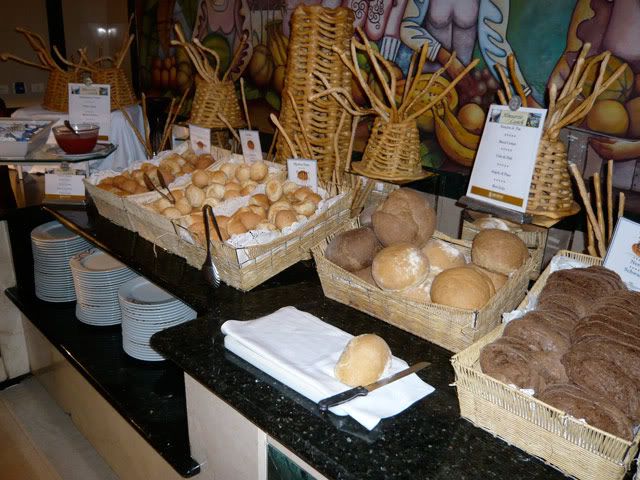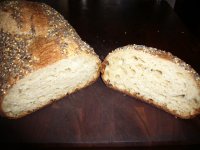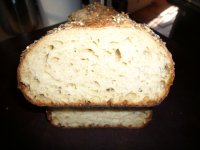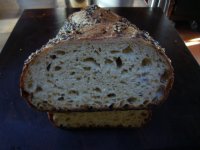I have never mastered the art of bread baking. Sure, I can make biscuits, cornbread and quick breads but I'm talking about yeast breads. I bought America's Test Kitchen TV Show Cookbook for the first 10 seasons and it came with the dvds for all of the episodes. I really want to make the multi-grain bread. It was light and airy when they made it on tv but although my first 2 attempts have yielded wonderfully tasting bread, it was dense and did not brown well. I think that it will make wonderful french toast so it won't be going to waste but it is not even close to being what I was hoping for.
Here is what their bread looked like:

Here is what my bread looked like:

So, here is the recipe and the instructions along with the pics of MY bread for each step. I'm hoping someone can tell me where I went wrong.
1 1/4 cups (6 1/4 ounces) seven grain hot cereal (I used and they recommend Bob's Red Mill)
2 1/2 cups boiling water
3 cups (15-ounces) unbleached All-Purpose Flour, plus extra for the dough and work surface
1 1/2 cups (8 1/4 ounces) whole wheat flour (the DVD said to use 7 1/2 which is what I used for the second batch)
1/4 cup honey
4 tablespoons (1/2 stick) butter, melted and cooled slightly
1 envelope (2 1/4 teaspoons) of rapid rise yeast
1 tablespoon table salt
3/4 cup of unsalted pumpkin seeds or sunflower seeds (I used sunflower seeds)
1/2 Old Fashioned Rolled Oats or Quick Oats (I used Old Fashioned)
1) Place the cereal mix in the bowl of a standing mixer and pour the boiling water over it; let stand, stirring occasionally until the mixture cools to 100° and resembles thick porridge; about 1 hour.
I used Bob's Red Mill. The one they recommended.

2) Whisk the flours together in a medium bowl.

3) Once the grain mixture has cooled, add the honey, melted butter and yeast and stir to combine.

The yeast had not been opened and had in the fridge with an expiration date of May 2011. I got it out 1 hour before using.
4) Attach the bowl to a standing mixer fitted with a dough hook. With the mixer running on low speed, add the flours a half a cup at a time, and knead until the dough forms a ball, 1 1/2 to 2 minutes.

5) Cover the bowl with plastic wrap and let the dough rest 20 minutes.

6) Add the salt and knead on medium-low speed until the dough clears the sides of the bowl, 3 to 4 minutes (if it does not clear the sides, add 2 to 3 tablespoons of additional All-Purpose Flour and continue mixing); continue to knead the dough for 5 more minutes.

7) Add the seeds and knead for 15 more seconds.

8) Transfer the dough to floured work surface and knead by hand until the dough forms a smooth, taut ball.
9) Place the dough in a greased container with a 4-quart capacity; cover with plastic wrap and allow to rise until double in size, 45 to 60 minutes.

continued in the next post......
Here is what their bread looked like:
Here is what my bread looked like:
So, here is the recipe and the instructions along with the pics of MY bread for each step. I'm hoping someone can tell me where I went wrong.
1 1/4 cups (6 1/4 ounces) seven grain hot cereal (I used and they recommend Bob's Red Mill)
2 1/2 cups boiling water
3 cups (15-ounces) unbleached All-Purpose Flour, plus extra for the dough and work surface
1 1/2 cups (8 1/4 ounces) whole wheat flour (the DVD said to use 7 1/2 which is what I used for the second batch)
1/4 cup honey
4 tablespoons (1/2 stick) butter, melted and cooled slightly
1 envelope (2 1/4 teaspoons) of rapid rise yeast
1 tablespoon table salt
3/4 cup of unsalted pumpkin seeds or sunflower seeds (I used sunflower seeds)
1/2 Old Fashioned Rolled Oats or Quick Oats (I used Old Fashioned)
1) Place the cereal mix in the bowl of a standing mixer and pour the boiling water over it; let stand, stirring occasionally until the mixture cools to 100° and resembles thick porridge; about 1 hour.
I used Bob's Red Mill. The one they recommended.
2) Whisk the flours together in a medium bowl.
3) Once the grain mixture has cooled, add the honey, melted butter and yeast and stir to combine.
The yeast had not been opened and had in the fridge with an expiration date of May 2011. I got it out 1 hour before using.
4) Attach the bowl to a standing mixer fitted with a dough hook. With the mixer running on low speed, add the flours a half a cup at a time, and knead until the dough forms a ball, 1 1/2 to 2 minutes.
5) Cover the bowl with plastic wrap and let the dough rest 20 minutes.
6) Add the salt and knead on medium-low speed until the dough clears the sides of the bowl, 3 to 4 minutes (if it does not clear the sides, add 2 to 3 tablespoons of additional All-Purpose Flour and continue mixing); continue to knead the dough for 5 more minutes.
7) Add the seeds and knead for 15 more seconds.
8) Transfer the dough to floured work surface and knead by hand until the dough forms a smooth, taut ball.
9) Place the dough in a greased container with a 4-quart capacity; cover with plastic wrap and allow to rise until double in size, 45 to 60 minutes.
continued in the next post......











 ) I'm ready to tackle this recipe again. The look and feel of this dough was very similar to the dough from my first attempt at the honey whole wheat bread that I wasn't happy with I'm going to make some of the adjustments that I made to wheat bread. This recipe makes 2 loaves, I'm going to use 2 packages of Rapid rise yeast instead of the one that the recipe calls for and I'm going to add 2 Tablespoons of VWG. Otherwise, I'm going to keep everything else the same. Wish me luck! I'll post pics when it's done.
) I'm ready to tackle this recipe again. The look and feel of this dough was very similar to the dough from my first attempt at the honey whole wheat bread that I wasn't happy with I'm going to make some of the adjustments that I made to wheat bread. This recipe makes 2 loaves, I'm going to use 2 packages of Rapid rise yeast instead of the one that the recipe calls for and I'm going to add 2 Tablespoons of VWG. Otherwise, I'm going to keep everything else the same. Wish me luck! I'll post pics when it's done.